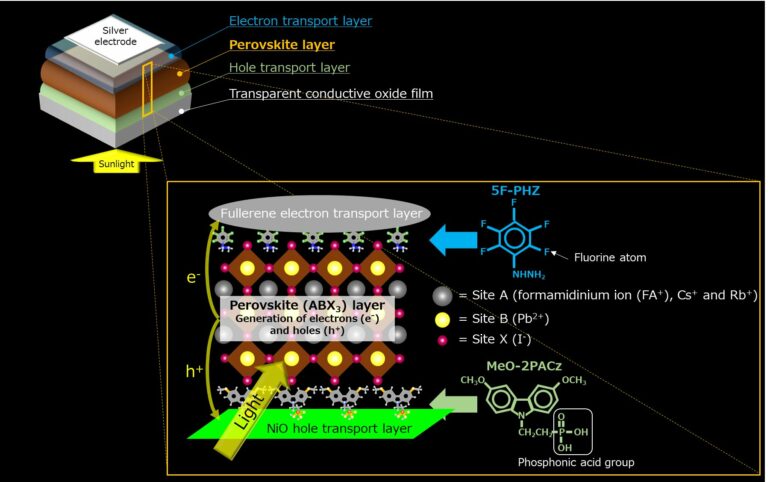NIMS has developed a durable 1-cm2 perovskite solar cell capable of generating electricity for more than 1,000 continuous hours at a photoelectric conversion efficiency (i.e., power generation efficiency) of more than 20% in exposure to sunlight. Because this solar cell can be fabricated on the surface of a plastic material at approximately 100°C, this technique may be used to develop light, versatile solar cells.
Solar cells have been a vital component of decarbonization policies, making them the subject of intense research around the globe. Perovskite solar cells are a potentially promising next-generation solar cell technology because they can be produced more easily and at lower cost than conventional solar cells. However, perovskite solar cells also have disadvantages: they are prone to degradation when they react with water molecules and it had proven difficult to make them both durable and highly efficient.
Most perovskite solar cells have similar power generation mechanisms. When the perovskite layer absorbs sunlight, it generates electrons and holes. These electrons and holes then migrate separately into the adjacent electron transport layer and hole transport layer, respectively, where they flow to produce an electric current. To simultaneously improve the efficiency and durability of perovskite solar cells, these layers and the interfaces between them need to enable electrons and holes to move through them more freely while rendering the interfaces impermeable to water molecules.
This research team added a hydrazine derivative containing water repellent fluorine atoms (5F-PHZ) to the interface between the electron transport layer and the perovskite layer (composed of a crystalline structure, FA0.84Cs0.12Rb0.04PbI3, which can be expressed simply by ABX3, where A = a combination of formamidinium ions (FA+), Cs+ and Rb+; B = Pb2+; and X = I–).
This interface successfully prevented water molecules that have penetrated the electron transport layer from coming into contact with the perovskite layer, thereby improving the durability of the solar cell. The use of this interface also reduced the number of crystalline defects that formed on the surface of the perovskite layer—a cause of decreased power generation efficiency. In addition, the team added a phosphonic acid derivative (MeO-2PACz) to the interface between the hole transport layer and the perovskite layer, which minimized defect formation in the hole transport layer and thereby improved the power generation efficiency of the solar cell.
The study is published in Advanced Energy Materials. In future research, the team plans to develop even more efficient and durable perovskite solar cells by creating a database of molecules that can be integrated into the interface, conducting data-driven research and designing molecules that can be used to improve interfacial properties.
More information:
Dhruba B. Khadka et al, Interfacial Embedding for High‐Efficiency and Stable Methylammonium‐Free Perovskite Solar Cells with Fluoroarene Hydrazine, Advanced Energy Materials (2022). DOI: 10.1002/aenm.202202029
Provided by
National Institute for Materials Science
Citation:
Achieving photovoltaic power generation for over 1,000 continuous hours, efficiency more than 20% (2022, October 7)



